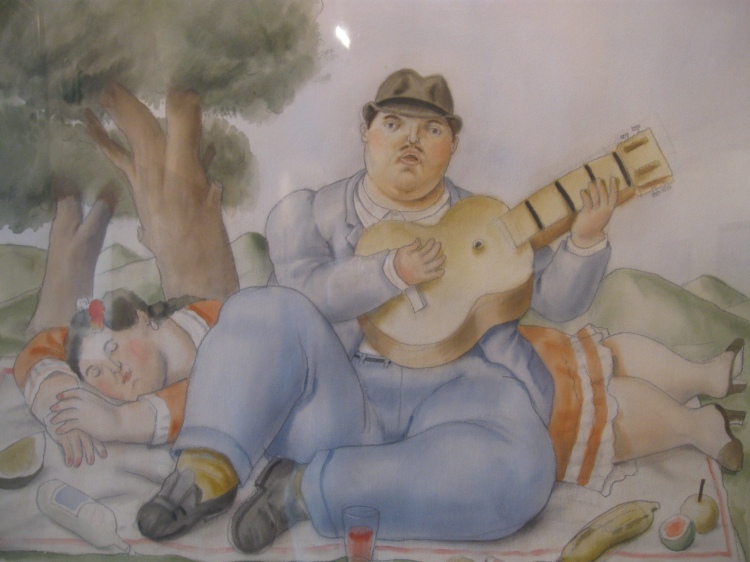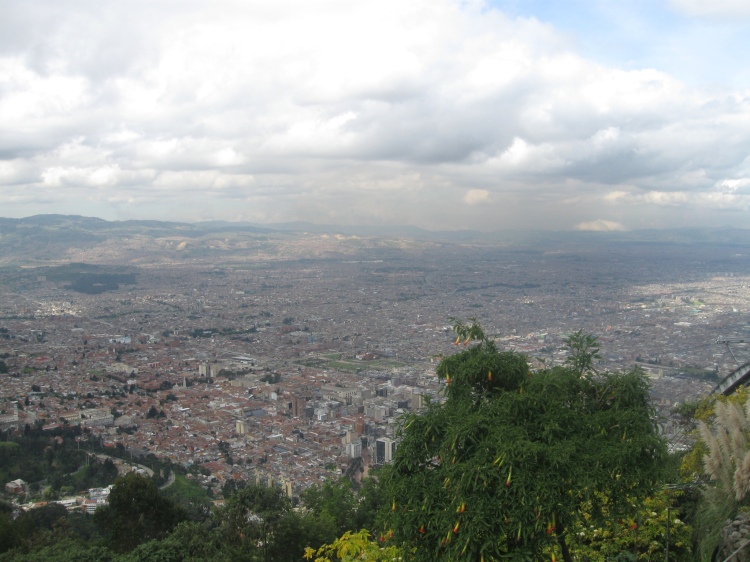Ms. D and I recently escaped to Bogota for a short visit to Colombia’s capital. A city of about eight million, it’s one of the largest in South America. It’s also a difficult city to get an unbiased opinion on, at least from Colombians. Many Paisas will tell you Bogota is cold (both the weather and the people), polluted, and far too dense, whereas Rolos (the people of Bogota) will tell you it’s the best city in in the country. And so it is in Colombia as it is in many other parts of the world, where citizens of one city will feel proud of both their city and their country, but simultaneously speak disparagingly about the nation’s “rival” big city.
We knew we’d have to check this one out for ourselves to form an opinion of our own.
We opted to stay in the city’s La Candelaria neighbourhood, Bogota’s historic centre and old town. The area is home to many of Bogota’s tourist attractions, and seemed the most logical choice for a brief two-night visit. We landed mid-morning and caught a taxi from the airport to the centre of the city, checking into our hotel by noon. We immediately took to the streets to get our bearings and gaze at the city’s colonial architecture, certainly one of Bogota’s defining characteristics. La Candelaria has been well preserved, or at least well-restored, and the result is a distinctly European feel that we hadn’t experienced yet during our time in Colombia.
We visited several of the recommended museums, including the Gold Museum and the Botero Museum. Bogota’s core proved to be friendly towards pedestrians, with several large streets entirely dedicated to the meek and car-less. Ms. D got some shopping done, and we made sure to stop at an empanada spot to sample the local variety. The verdict: less grease (perhaps baked?), and with way more communal dipping sauces to be enjoyed, cross contamination be damned.
The evening brought us on a fruitless hunt for a specific restaurant, something of a Sunday evening tradition for Ms. D and I. Accompanied by our fearless leader/random stray dog, we wandered up and down La Candelaria’s sloped streets, passed mostly shuttered businesses. We ended up settling on Pita Wok, a fast food-y looking establishment that is either confusingly or perfectly named. They serve pitas. Also food prepared in a wok. Let’s just call it Meditterasian cuisine and move on. It was surprisingly delicious (glorious hummus, oh how I’ve missed you old friend), and located almost directly across the street from one of Bogota Beer Company’s many pubs, is fortuitously located for the thirsty traveller.
We awoke the next morning and headed straight for Monserrate mountain, one of Bogota’s most loved tourist destinations. We ascended in the teleferico, and were immediately struck by the sheer scope of Bogota. Whereas Medellin is nestled in a narrow valley, Bogota sits on a plateau, with steep mountains on one side and the dramatically sprawling city covering the land almost as far as the eye can see in the opposite direction, even from the elevated vantage point afforded to visitors of Monserrate.
Upon descent, Ms. D and I decided to visit one of the city’s northern neighbourhoods, considered to be one of Bogota’s more upscale destinations. We wandered around Usaquen, peering into the small shops and restaurants and browsing a craft market as the vendors were still setting up their goods. While we’d taken the city’s principle public transit system, the Transmilenio buses, as well as a taxi to reach Usaquen from La Candelaria, we opted to take a different path on the way home. We’d noticed a regular old city bus passing by with Candelaria listed as one of its destinations, and figured we’d save the taxi fare and take the city bus all the way back to our hotel. This proved to be something less than the best decision we could have made.
From almost the moment we hopped on the bus, it seemed to be heading in not quite the direction of our intended destination. When we hoped it would turn right, it would turn left. Free tour, we thought. But as we bumped along, our tour of dreary south Bogota lacking anything resembling pleasant sight seeing, and with the clock ticking into it’s second hour, we realized it was time to take action. Ms. D. approached the bus driver, and half-shouting through the protective glass, inquired about reaching La Candelaria, the tourist centre. “Oh, you want the old Candelaria” replied the driver, “This is the new Candelaria.” The new Candelaria, a low-income area that resembled some of Medellin’s poorer barrios, was in fact a world apart from the neighbourhood we were staying in. “You should get off here and take a taxi,” advised the driver in Spanish. “But be careful…it’s dangerous.”
Shoving my $5.00 sunglasses into my pocket, we descended the stairs of the bus, and quickly made our way to what appeared to be the area’s principal street. We hailed a cab in short order, the driver eager to ask us just what the hell we were doing in this part of town. He advised it would be most economical, both in terms of money and time, for us to simply cab to the nearest Transmilenio terminal, and take the central bus system from there.
Our experience with the new Candelaria was brief, and truth be told the area appeared very similar to where I spend a good deal of time in Medellin while volunteering (to be detailed in a future post). It’s not a destination I would recommend to other tourists though, and certainly not somewhere I would want to find myself after dark.
Upon arrival at the Transmilenio station, we had three Colombians eager to simultaneously explain the best way for us to get back to our hotel, speaking rapidly and doing their best to talk over one another. Slightly confused, we boarded a bus, knowing we had to transfer but not totally sure where. Fortunately, as so often seems to happen in South America, a friendly local took it upon himself to make sure we got home safely. The old man exited the first bus with us, walked us through the transfer station, and brought us to the correct spot to wait for bus number two. As our bus arrived, he pulled a laminated newspaper article out of his jacket, featuring a story that was apparently about him, and handed me a piece of what appeared to be vintage Colombian currency, cautiously warning me against folding it. I’m still confused about who this man was, why their was a newspaper article about him, how he fit an article into his jacket pocket, and what kind of currency he handed to me. Alas, we soon parted ways, boarded our next bus, and were back in the proper Candelaria only minutes later.
We spent another day in Bogota, exploring and soaking in the big city vibe. Both Ms. D and I appreciated the gritty aspect of the Colombian capital. There is a much greater level of cultural diversity than in Medellin, and I’m sure we’d find a welcoming scene were we ever to spend a significant amount of time in the city. As it was, we enjoyed our short holiday in Bogota, and were satisfied with finally being able to form an opinion of our own about one of South America’s most inhabited cities.


Discussion
No comments yet.